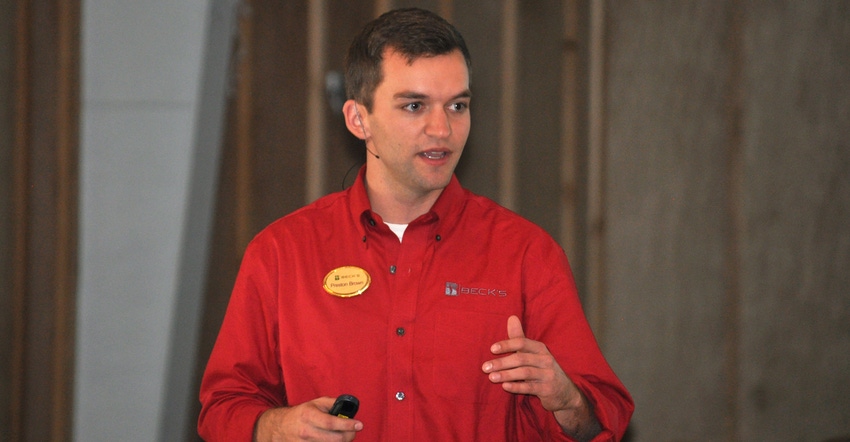
Questions surrounding crop management and input decisions arise every year. When’s the best time to plant corn? Can lower seeding rates produce solid returns? Do fungicides provide enough bang for the buck?
Jon Skinner, agronomist for Beck’s, says the information the seed company offers in its Practical Farm Research isn’t a rule book, but it’s a resource that looks at several agronomic practices and products to determine return on investment.
“PFR Proven recommendations shouldn’t be taken as the gospel,” says Preston Brown, seed adviser. The research, started in 1964 and now conducted in five states, provides confirmation on agronomic products and practices, and offers new ideas to try on farms.
Skinner and Brown share a few highlights from Beck’s 2016 PFR:
1. Planting dates. The best time to plant corn in southern Illinois is early April, while the last two weeks are ideal for northern Illinois. Soybeans planted in mid-April through mid-May outperformed beans planted in the four weeks that followed and provided a $146-per-acre net return. Brown says farmers shouldn’t hesitate to plant when weather and soil conditions are right. “Planting early pays,” he adds. “Don’t wait to get seed in the ground.”
2. Nitrogen rates. Skinner says eight years of research across multiple locations indicates that 182 to 192 units is the economic optimum nitrogen rate (EONR) for corn following soybeans. Several factors impact crop nitrogen needs, including: soil type, drainage, spring rain, pH, residue, application timing and the previous crop. The EONR for continuous corn is 212 to 221 units. Skinner notes nitrogen rates provided by PFR results are a baseline for on-farm programs, not specific recommendations.
3. Nitrogen programs. Skinner says testing protocol included “just about every nitrogen program you could think of,” including different forms and timing. The highest-performing nitrogen program was 30 units, 2-by-2 at planting, plus 160 units sidedress at V3. “Applying 160 units in season is a little bold, but remember those environmental factors,” he adds. Soil type, drainage, rain, pH and residue all impact nitrogen program rates and methods.
4. Fungicide timing. Brown says PFR test results show a full-rate fungicide application at tassel provides a $20-per-acre return. Applications made at V3, and split between V3 and tassel, did boost yield, but didn’t provide a significant return. The V3 application alone resulted in a negative return. He recommends making final fungicide decisions based on disease pressure, environmental conditions and hybrid response.
5. Soybean populations. Skinner encourages farmers planting 150,000 to 160,000 seeds per acre to try reducing rates on a few check plots. Their research shows the economic optimum seeding rate for soybeans is 100,000 seeds per acre. He adds that low populations won’t work in every soil type, but it could be worth an on-farm trial.
Find complete PFR testing results online.
About the Author(s)
You May Also Like




